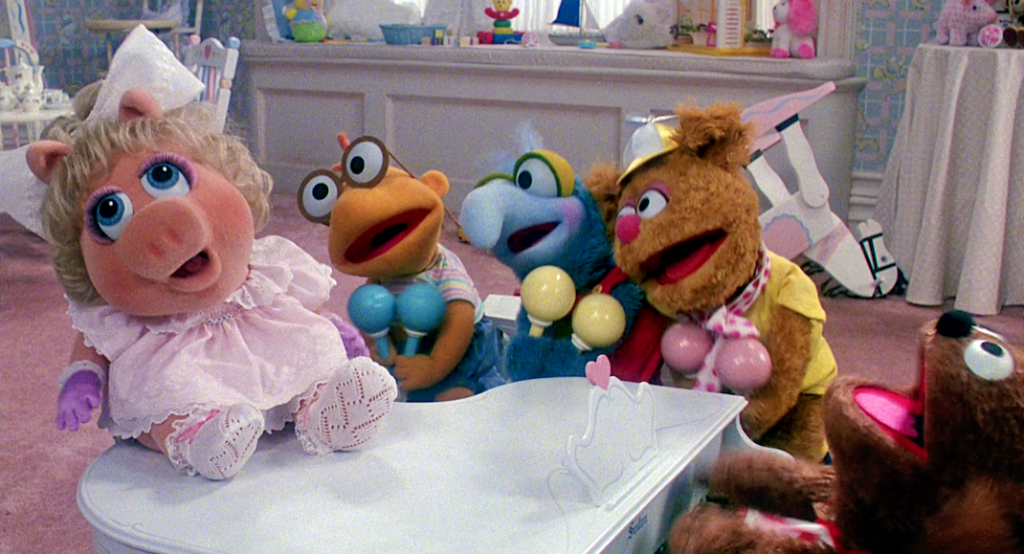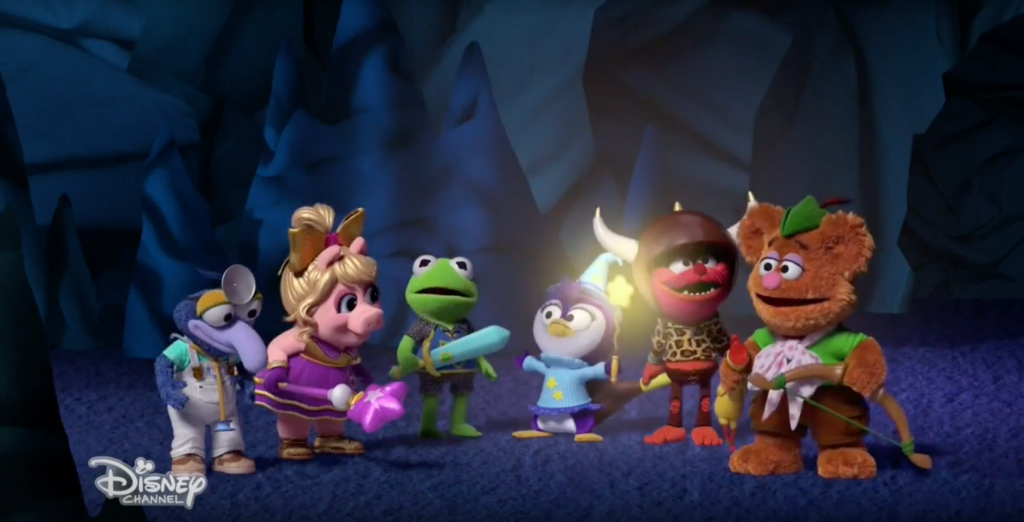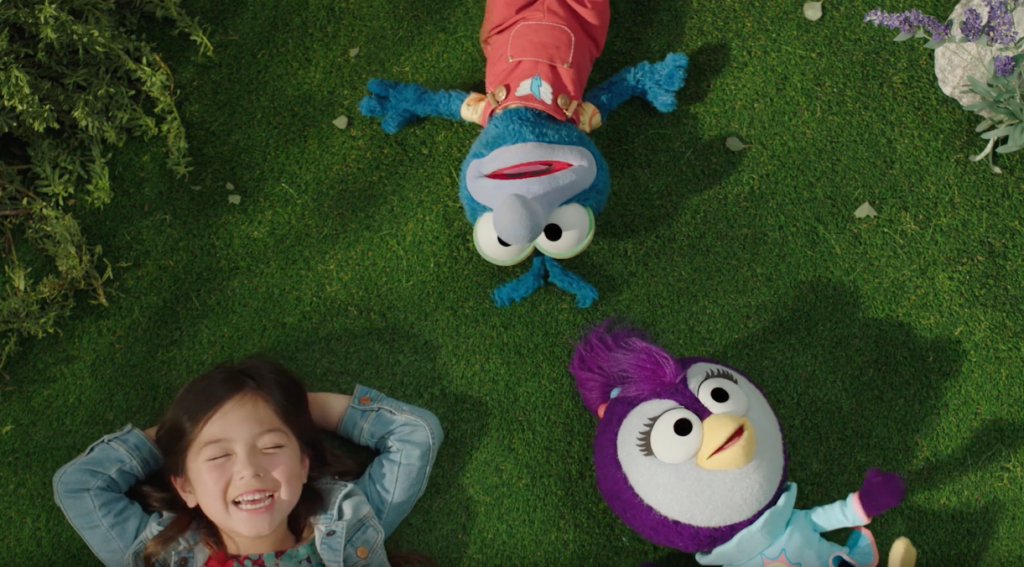Forty years after the release of The Muppet Movie (dir. James Frawley) in June 1979, it seems fitting to celebrate the lasting contribution of Jim Henson to puppet animation by considering the Muppet Babies: Play Date shorts on YouTube in the Summer of 2019. How far have they come? Perhaps, as one reviewer suggests, “full circle.” Matthew Soberman (2019) writes: “First, they were puppets in a movie. Then, they were animated characters. Then, they were computer-animated characters. And now, they’re puppets once again.” Play Date also represents another important return. As with Henson’s work on Sesame Street (1969-), the characters engage their human playmates, onscreen and in the audience. This inserts the Muppet Babies (1984-1991: 2018-) –like their adult counterparts–into our world.
This post takes as its inspiration sequential talks from this year’s Society for Cinema and Media Studies Conference, Cristina Formenti’s “Shaping Cartoon Identities: The Twitter Mock-autobiographies of Contemporary Televisual Animated Characters” and Christopher Holliday’s “Retroframing the Future: Digital De-Aging Technologies in Contemporary Hollywood Cinema,” inferring that the Muppet Babies offer a novel dialogue between them. Rebooted thirty-four years after their first introduction, toddler Kermit, Piggy, and friends challenge the understanding of these familiar characters as ‘real’ celebrities. Yet their CGI animated representations are greeted by complaints that they are too real, with Kermit eliciting “existential nausea” (Adams, 2016) like a de-aged human star. The physical puppets in Play Date seem tailor-made to address both concerns.
The Muppet’s familiar play of real and imaginary has not always been so desirable. In early Sesame Street tests, puppets and children did not share the screen to avoid confusing young viewers (Fisch and Bernstein, 2001: 39). Nonetheless, it proved to be characters performing alongside humans that would define the Muppets across film and television. In The Muppet Show (1976-1981) not only did they share a stage, it was the puppets putting on the show. This established lasting conventions: live performance blurred with backstage drama, and a corresponding confusion between performer and audience (Underwood, 2009: 15). By The Muppet Movie, they were the test audience for their own origin story, which they eventually produced. The Muppets follow a tendency observed by Vivian Sobchack (2004: 264) to, “cast cultural celebrities as themselves.” In A Muppet Christmas Carol (1992, dir. Brian Henson), The Great Gonzo is not only Charles Dickens, producing the odd situation where the authentication of the fiction rests on the celebrity of a puppet. Likewise, as Formenti (2019) has observed in Kermit and Piggy’s ostensive self-promotion on Twitter, this performance amounts to a kind of “mock autobiography” as the imaginary world of the characters is incorporated into our own. Yet, as the Muppet Babies demonstrate, this incorporation need neither be seamless or consistent.
Babies Make a Mess. Infant versions of the familiar Muppet characters first appeared in Muppets Take Manhattan (1984, dir. Frank Oz) in the song “I’m Gonna Always Love You” (see Figure 1). Although denying its own reality, the appeal of this sequence inspired a wholly different kind of Muppet production, an animated series on CBS. In addition to the switch to animation, Muppet Babies tweaked the backstage logic of the Muppets. Rather than putting on a vaudeville show, they entertain themselves through the power of imagination, often, as in “Muppet Babies the Next Generation” (episode 708, 1990) with obvious pop-culture referents. This is also true of the original puppet Muppet babies, who continued to appear in Muppet Magazine, calendars, books, and games, enacting nursery rhymes and stories through 1990.

From the start, as a seeming outlier to other Muppets texts, it is tempting to make Muppet Babies fit. How can Kermit and Piggy have played together as infants if Kermit grew up in a swamp and only met the others as adults? One imaginative explanation, takes inspiration from a central critique of the show’s existence, as a merchandising opportunity. Given the Muppets perform so many aspects of showbiz practice, if the Muppet Babies is a brazen spin-off of Muppets Take Manhattan, perhaps it is licensed not by Jim Henson Productions as it might seem, but by the Muppets themselves? Fast forward to 2016–and the Muppets on ABC and Twitter–this seems like a deal Kermit might approve.
Regardless of Kermit’s personal input, the rebooted Muppet Babies (2018-) follows a similar narrative format to the original, albeit with a very different production aesthetic (see Figure 2). Unlike the earlier 2D series, the producers of the new CGI series profess a far closer relationship between the appearance of the characters and their adult puppet forms, so that they “look like real Muppets.” As Executive Producer Tom Warburton told Entertainment Weekly:
You feel like you can reach in and touch the little tennis ball texture that Kermit has…There’s something really tactile about that and I think for viewers it really draws you into the show (qtd. in Gomez 2019).

(episode 101, 2018).
Clearly, not everyone was sold on this change, as AV Club’s Erik Adams (2016) argued, the computer-generated Kermit is too real: “Puppet arms should be floppier than that. This image is off-putting because it wants us to think that Baby Kermit has bones.” This critique is given at least some weight by Disney Junior’s subsequent decision to release a series of shorts performed by physical puppets. As if in response, Warburton not only affirms the reality of the puppet but even goes so far to suggest that an adult Kermit was involved in the concept, acting out a skit on a slide with the production assistant’s niece (Gomez, 2019). This promotional anecdote conveniently echoes, both the wider tradition of the Muppets as actors and specifically “Rainbow Connection” co-writer Paul William’s story that Kermit was necessary with Jim Henson in the recording booth in order to perform the song (Leibenson, 2019). In both instances, even if the real Kermit is not onscreen, his embodied presence is somehow required.
The De-Aged Puppet Body. In addition to blurring animation and live-action, Play Date also raises an odd case of physical de-aging. In comparison to VFX de-aging of a human character, de-aging a puppet form seems straightforward. Taking Warburton’s trade narrative at his word, and assuming that adult and baby Kermit are more or less literally built of the of same stuff[ing], what are we to make of a de-aging effect that is seemingly more perfect in its simplicity than can be achieved by animation (see Figure 3)? This is made all the more unusual as the fidelity of the effect seems to require a physical body. However, it is unclear how much of this illusion is inherent in that limited form–but in the captivating relationship between the puppet and the puppeteer.

“Let’s Play Together” (May 17, 2019).
Whether visible or hidden, the role of the puppeteer is to seduce the audience into the belief that the puppet is real and then make it clear that it is not. This repetition of claim and denial comes from the characters themselves–as ventriloquist Nina Conti asserts, “the more the puppets know they’re not real the more they become real” (qtd. in Smith, 2013). Furthermore, the performance of this becomes a relationship between the puppet and the puppeteer, “a weird dance” for control: sometimes the puppeteer has the upper hand, and sometimes the puppet. In Muppets Take Manhattan, baby Piggy sings with her adult voice–that of Oz the puppeteer–, undermining the reality of the sequence in a way the visual performance alone does not. Conversely, in Play Date, the puppeteers are less present as the babies have their own–noticeably higher–voices from the animated series.
What interest can this rather silly inquiry offer to animation studies? On the surface, the Play Date shorts are presented as a live-action bridge to an animated series. In structure and meta-narrative conceit, they fall within the larger form of virtually all Muppet texts, one that is not only familiar to animation but central to the study of animation as well. Across Muppet texts, the impresario, Henson, his designated successors, and characters play off each other again and again. It is as if Winsor McCay introduced Gertie the Dinosaur (1914), made her a star, and the next show were introduced by Gertie herself, only for McCay to turn up once again.
Like Gertie before them, the Muppet babies possess constructed bodies, that “unsettle conventional notions of a stable, bounded, coherent” self (Crow, 2007: 51). As Play Date clearly demonstrates, the Muppets can and do embody multiple bodies, infant and adult, real and animated as they move back and forth across worlds of imagination and actuality. Yet ultimately here that engagement with the real is something much more visceral, as their embodiment is alongside real people–who both perform with them and laugh at their constructed silliness. At least as much as in The Muppet Show or Twitter, this too is a transformation of “fictional into documentary space” (Sobchack, 2004: 276). As the producers of Sesame Street quickly discovered in 1969, the imaginary world of the childlike puppets is “charged” not only by their celebrity but by real children, likewise playing themselves (see Figure 4).

Even with this call back to earlier Muppets performance, these new real Muppet Babies remain difficult to fit. Is their inconsistency an extension of backstage comedy, mockumentary, or simply the continuing battle of puppet and puppeteer? In which case, perhaps it is Kermit all the way down? Regardless, in assessing Jim Henson’s lasting contribution to puppet animation (and animation more broadly) this messy play between the real and irreal–and in Muppet Babies childlike imagination–is and has always been an attraction.
Timothy Jones is an Assistant Professor of Media Arts and Director of the Academic Media Center at Robert Morris University where he teaches courses in media culture and production. His research interests include inclusive practices in animation education, local production culture, and the intersection of cinema and beer. His recent work on Indian animation policy and boutique commercials has appeared in the edited collections Reconceptualizing Film Policies (Routledge 2017) and the upcoming Animated Advertising.
References
Adams, E. (2016), “The New Muppet Babies Will Make Your Dreams Uncomfortable,” AV Club, October 26, https://news.avclub.com/disney-s-new-muppet-babies-will-make-your-dreams-uncomf-1798253504?/setsession (Accessed June 23, 2019).
Crow, H. (2007), “Gesturing Towards Olympia,” in S Buchan (ed.), Animated Worlds, U of Indiana P, Bloomington, pp. 49-62.
Fisch, SM. and Bernstein, L. (2001), “Formative Research Revealed: Methodological and Process Issues in Formative Research,” in Fisch M and Ruglio R (eds.), “G” is for Growing: Thirty Years of Research on Children and Sesame Street, Lawrence Erlbaum, Mahweh, New Jersey, pp. 39–60.
Formenti, C. (2019) “Shaping Cartoon Identities: The Twitter Mock-autobiographies of Contemporary Televisual Animated Characters” presented at Society for Cinema and Media Studies, Annual Conference, Seattle, March 14.
Gomez, P. (2019), “They’re not just animated anymore! See the new Muppet Babies as actual Muppets,” Entertainment Weekly, May 17, https://ew.com/tv/2019/05/17/disney-junior-muppet-babies-real-muppets-exclusive-photo-video-interview/ (Accessed 20 June 2019).
Holliday, C (2019) “Retroframing the Future: Digital De-Aging Technologies in Contemporary Hollywood Cinema,” presented at Society for Cinema and Media Studies, Annual Conference, Seattle, March 14.
Liebenson, D. (2019), “A Frog, a Banjo, and an Indelible Message: Making ‘The Rainbow Connection,’” Vanity Fair, June 21, https://www.vanityfair.com/hollywood/2019/06/rainbow-connection-muppet-movie-kermit-the-frog-making-of (Accessed 23 June 2019).
Sobchack, V. (2004), Carnal Thoughts, Embodiment, and Moving Image Culture, U of California P, Berkeley.
Soberman, M. (2019), “Muppet Babies Come Full Circle With Puppet Shorts on YouTube,“ Tough Pigs, May 17, http://www.toughpigs.com/muppet-babies-puppets/ (Accessed 20 June 2019).
Smith, A. (2013),“The Uncanny Life of Puppets,” The Body Sphere, April 9.
https://www.abc.net.au/radionational/programs/archived/bodysphere/the-uncanny-life-of-the-puppet/4604708 (Accessed 23 June 2019).
Underwood, B. (2009), “How to Become a Muppet; or The Great Muppet Paper,” in J Garlen and A Graham (eds.), Kermit Culture: Critical Perspective’s on Jim Henson’s Muppets, McFarland and Co., Jefferson and London, pp. 9-24.

I Want To Join Too
Great article.
My favorite subject, but very well handled.
Thanks
Love this. Thank you for taking the time to write this up. Wonderfully thoughtful.
Thanks Ron!